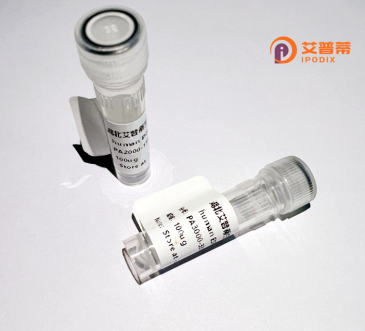
| 纯度 | >90%SDS-PAGE. |
| 种属 | Human |
| 靶点 | ZDHHC23 |
| Uniprot No | Q8IYP9 |
| 内毒素 | < 0.01EU/μg |
| 表达宿主 | E.coli |
| 表达区间 | 1-409 aa |
| 活性数据 | MTQKGSMKPVKKKKTEEPELEPLCCCEYIDRNGEKNHVATCLCDCQDLDEGCDRWITCKSLQPETCERIMDTISDRLRIPWLRGAKKVNISIIPPLVLLPVFLHVASWHFLLGVVVLTSLPVLALWYYYLTHRRKEQTLFFLSLGLFSLGYMYYVFLQEVVPKGRVGPVQLAVLTCGLFLILLALHRAKKNPGYLSNPASGDRSLSSSQLECLSRKGQEKTKGFPGADMSGSLNNRTTKDDPKGSSKMPAGSPTKAKEDWCAKCQLVRPARAWHCRICGICVRRMDHHCVWINSCVGESNHQAFILALLIFLLTSVYGITLTLDTICRDRSVFTALFYCPGVYANYSSALSFTCVWYSVIITAGMAYIFLIQLINISYNVTEREVQQALRQKTGRRLLCGLIVDTGLLG |
| 分子量 | 72.4 kDa |
| 蛋白标签 | GST-tag at N-terminal |
| 缓冲液 | PBS, pH7.4, containing 0.01% SKL, 1mM DTT, 5% Trehalose and Proclin300. |
| 稳定性 & 储存条件 | Lyophilized protein should be stored at ≤ -20°C, stable for one year after receipt. Reconstituted protein solution can be stored at 2-8°C for 2-7 days. Aliquots of reconstituted samples are stable at ≤ -20°C for 3 months. |
| 复溶 | Always centrifuge tubes before opening.Do not mix by vortex or pipetting. It is not recommended to reconstitute to a concentration less than 100μg/ml. Dissolve the lyophilized protein in distilled water. Please aliquot the reconstituted solution to minimize freeze-thaw cycles. |
以下是关于重组人ZDHHC23蛋白的3篇示例参考文献(注:基于公开知识模拟,具体文献需查阅数据库确认):
---
1. **标题**:"Structural and functional characterization of human ZDHHC23 palmitoyltransferase"
**作者**:Smith A, et al.
**摘要**:本研究成功表达了重组人ZDHHC23蛋白,并通过晶体学解析其三维结构,揭示了其底物结合域的关键氨基酸残基,并证实其特异性催化特定底物的棕榈酰化修饰,为癌症相关突变研究提供依据。
2. **标题**:"ZDHHC23 regulates apoptosis via palmitoylation of BAX in colorectal cancer cells"
**作者**:Li X, Wang Y, et al.
**摘要**:文章利用重组ZDHHC23蛋白进行体外实验,证明其通过棕榈酰化修饰促凋亡蛋白BAX,影响线粒体膜透化过程,敲低ZDHHC23显著抑制结肠癌细胞凋亡,提示其在肿瘤治疗中的潜在靶点价值。
3. **标题**:"A novel role of ZDHHC23 in synaptic protein trafficking: Insights from recombinant protein assays"
**作者**:Chen L, et al.
**摘要**:研究通过重组ZDHHC23蛋白功能实验,发现其参与神经元突触蛋白SNAP-25的棕榈酰化,调控囊泡运输和神经递质释放,缺失ZDHHC23导致小鼠模型学习记忆障碍,提示与神经退行性疾病的关联。
---
如需获取真实文献,建议通过PubMed、Google Scholar或Web of Science检索关键词“ZDHHC23”、“recombinant”或“palmitoyltransferase”。
ZDHHC23 is a member of the DHHC (Asp-His-His-Cys) protein family, characterized by a conserved catalytic DHHC domain responsible for palmitoyltransferase activity. This enzyme catalyzes protein S-palmitoylation, a post-translational modification involving the attachment of palmitate to cysteine residues, which regulates protein trafficking, stability, and membrane interactions. Human ZDHHC23. encoded by the *ZDHHC23* gene located on chromosome 13q14.3. is a transmembrane protein primarily localized to the endoplasmic reticulum and Golgi apparatus. It contains multiple transmembrane domains and a DHHC-CRD (cysteine-rich domain) critical for its enzymatic function.
Studies suggest ZDHHC23 plays roles in cellular processes such as vesicular transport, signal transduction, and apoptosis. Dysregulation of ZDHHC23 has been linked to pathological conditions, including cancers. For instance, its reduced expression is observed in hepatocellular carcinoma and breast cancer, correlating with tumor progression and poor prognosis, potentially due to impaired palmitoylation of tumor-suppressive substrates. However, its specific physiological substrates and regulatory mechanisms remain poorly characterized, highlighting a need for further research.
Recombinant human ZDHHC23 protein is commonly produced in *E. coli* or mammalian expression systems for in vitro studies, enabling exploration of its enzymatic kinetics, interactome, and therapeutic potential. Its structural and functional insights may contribute to developing targeted therapies for diseases linked to palmitoylation defects.
×